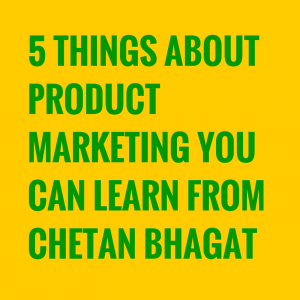As a product marketer specialising in content, I’ve always found it irksome to explain to people just how difficult my craft is, and how much time it takes to do it well. Building a brand isn’t easy; it takes a lot of effort, planning, strategy & execution, and involves as much editing out as it involved creating more. And even then, one misplaced word or misguided blog post can turn around and bite you (a case in point is the much maligned Uber’s Rides of Glory blog post, since deleted).
 But there is one gentleman (or a brand, however you choose to see him) who has consistently been so good at product marketing, that it would be a shame not to try to learn from him. Chetan Bhagat has been so good at selling books that several of our more established, critically acclaimed (and might I say, better) writers have had to go into therapy to treat their egos. He single handedly changed publishing in India, and though his methods may be suspect, they are nothing if not effective.
But there is one gentleman (or a brand, however you choose to see him) who has consistently been so good at product marketing, that it would be a shame not to try to learn from him. Chetan Bhagat has been so good at selling books that several of our more established, critically acclaimed (and might I say, better) writers have had to go into therapy to treat their egos. He single handedly changed publishing in India, and though his methods may be suspect, they are nothing if not effective.
From the beginning, I’ve looked at Chetan Bhagat as a product marketer, and not as a writer who’s good at selling books; one reason for that is that his ideas (& tradition, as he has spawned several copycats & me-too writers) offend my literary sensibilities. Books are respected repositories of our knowledge, wisdom & stories for a reason, and somehow Bhagat’s books (or products) seem to undermine the very reason books are written & read.
None of that, though is relevant in a discussion about selling books, of which he is an absolute master. There is much to be learnt about product marketing from this seller of mass-market paperbacks, and I’ve distilled five of them.
Here goes –
1. There’s no such thing as bad publicity
Bhagat goes out of his ways to court attention. There is a reason he consistently picks fights with what he calls ‘the literary elite’; they are a self serving bunch not concerned about writing for ‘the common man’, he says, and is constantly getting into debates with them on national television. He has no original ideas to share at these platforms; all he does is reiterate that India’s new English readers need simplicity and stories that make them feel good, and that he is providing it to them. But intellectual debate is not the point of his appearances at all. The point is to stay in the news and never to go out of the mainstream. If you are always in front of your potential consumers, of course the probability that they will buy your product goes up exponentially. This is Marketing 101!
2. Revenue doesn’t care if it comes from shameless self-promotion
All of Chetan Bhagat’s books have one very prominent (& jarring) common factor. He appears in all of them in the beginning, as himself, listening to the story he is going to tell. It is a cringeworthy opening set-piece that smacks of supremely lazy writing, but what it also is is a reiteration that the book the reader is holding in his hand is part of the Chetan Bhagat brand, more a proclamation of allegiance than worthy literature. In marketing, we call this real estate. If you have a place you can showcase your brand or your product, every inch of it has to be used. Chetan Bhagat is so good at this that he has literally used the product he sells, that is, his books, to sell his own brand. If that is not genius, I don’t know what is.
3. Create your own market
The Blue Ocean strategy was something that was taught to me in my MBA days. I remember thinking that it was a pretty neat concept, but then as college students are wont to do, promptly forgot about it. The first time it struck me how Chetan Bhagat had applied it, I was mesmerized. In short, the Blue Ocean strategy puts forth the idea that instead of trying to compete against an established company in a congested market, a better way to create value would be to create a new market in the first place and then, by virtue of being the only players in that space, surge ahead before anyone even thinks about catching up. Before Chetan Bhagat came into the scene, the simple language/easy to digest/cheap paperback novel did not exist, simply because no one knew that such a market existed and that it could be serviced and made heaps of money off. I wasn’t paying attention during my MBA, but Chetan Bhagat certainly was.
4. Tailor your product & communication to your audience
Chetan Bhagat know who he is writing for. His audience is not the reader who has been reading for years and knows the kind of books he prefers or doesn’t, who already has a favorite author or authors or who can distinguish between a Mills & Boon and a Penguin Classic. Bhagat does not write for them. He writes for an aspirational middle class for whom English is a distant second language. And he makes no bones about that fact; Bhagat never claimed to be Naipaul. When you are this clear about the market you are selling to, you usually cannot go wrong. And he doesn’t. His books are not high literature, but they are perfect for the people he is selling to.
5. Go for the low-hanging fruit; grab the easy-to-acquire customers first
Though product marketers are beginning to catch on to the fact that pageviews is largely a vanity metric, there is a certain segment of the online content factories that have made this their field of expertise. And the foremost among them is of course Buzzfeed. The overwhelming majority of Buzzfeed’s content are listicles and feel-good stories that can only be described politely as great for passing the time. But there can be no argument with the fact that they work. Buzzfeed is an extremely intelligent, data driven company (run on Valley money) that knows exactly what it is doing. It is low-brow because it chooses to be, because that’s where the money is, and because it’s so easy to get that money. Chetan Bhagat understands this. India’s English book readers are a minority; in a country with so many regional languages and low literacy levels, the market for literary fiction and nonfiction in English is relatively miniscule. But there are millions of people who can read and understand simple English, and since they had never been sold books to before, all Bhagat had to do was write his books and spread the word. The low-hanging fruit was his for the taking.
I’m sure there are many more things we product marketers can learn from him. If there is anything I’ve left out that you’ve noticed, do point it out. As they say, knowledge shared is knowledge gained, and a discussion featuring books, in whatever oblique way, can never be not fruitful.


